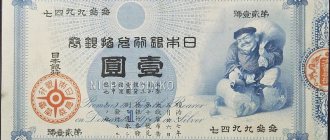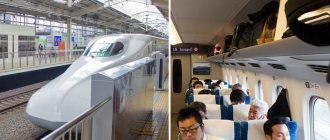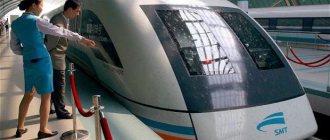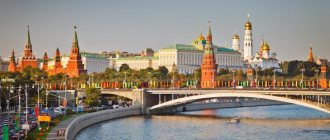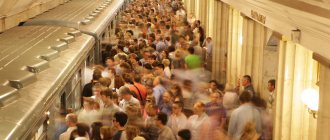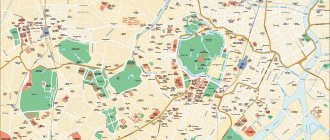High-speed trains in Japan: from 240 km/h to 320 km/h.
As someone said, Japan is a country out of this world. Indeed, Japan is considered one of the most high-tech countries. Some even claim that Japan has long been in the 22nd century. This is, of course, not true. Nevertheless, Japan has long surpassed many developed countries in terms of technology. Especially when it comes to high-speed trains.
Japan's railway fleet is one of the most modern and high-speed in the world. Only in this country can you not only see, but also ride on a large number of incredibly fast passenger trains, famous for their high speeds and unsurpassed punctuality.
Is it convenient to travel on high-speed trains in Japan? Reviews
It is worth noting that the Japanese took a thorough approach to their trains and station design. As travelers note, everything is decorated strictly, but very convenient. Each carriage has soft chairs, and you can buy coffee and other drinks from special vending machines. During the journey, special people offer to buy lunch. Moreover, judging by the reviews of tourists, the menu is very diverse. You can try traditional Japanese dishes such as sushi and ordinary sandwiches known throughout the world.
The only thing that will not please you during the trip is the landscape outside the window. Almost the entire route runs through cities and industrial zones. During the journey, the landscape does not change, and it is difficult to see something beautiful and traditional for Japan. If you come to the Land of the Rising Sun in winter, keep in mind that beautiful winter and Japanese trains are absolutely incompatible things. You won't be able to enjoy the snow-covered gardens, although their replicated views are one of the hallmarks of Japan. All the beauty of Japanese gardens is concentrated in city parks; outside their boundaries, a dull industrial landscape will appear to the eyes of the tourist.
The stations where the trains stop are very strict, but it is not difficult to navigate inside. At each station there are many signs made in different colors. Even intuitively, a tourist can understand where to go and where to buy a travel ticket.
Akita Line, Train E6, Japan East Railway
E6 series trains such as Akita reach an average speed of 128 km/h. Although the train in some sections travels at a speed of 320 km per hour.
Capacity: 336 people
Maximum speed: 320 km/h
The E6 train runs on a mini-high-speed line, part of which runs along the Tohoku railway line, which allows the train to accelerate to 320 km per hour.
However, as soon as the railway branches west towards Akita, the train's maximum speed drops from 320 to 128 km per hour.
see also
Chinese train with a top speed of 600 km/h will become a reality
Maglev L0, Japan
- Design speed: — km/h
- Top speed: 603 km/h
- Start of operation: 2020s
This experimental train has not yet entered service, but has already shown outstanding results in tests. Today it is the fastest train in the world, reaching a speed of 603 km/h. Tests were carried out in 2015 on a 40-kilometer section of the route. It is planned that by the end of the 2020s. it will connect Tokyo and Nagoya, and then the line for Maglev L0 will be completed to Osaka.
Joetsu Line - E7 and E4 train series, East Japan Railway
The E4 series (pictured) is unique in the Japanese railway fleet because it is a double-decker high-speed train
Capacity: 934 people (train E7), 1,634 people (train E4).
Maximum speed: 260 km/h (E7 train) and 241 km/h (E4 train)
The E7 and E4 series bullet trains are not obsolete, but are nevertheless the slowest in the railway fleet, with a maximum speed of 260 km/h and 241 km/h respectively.
However, the E4 series is unique in Japanese railway rolling stock because it is a double-deck train.
The train consists of eight carriages with a capacity of 1,634 seated passengers.
Sapsan, Russia
- Design speed: 250 km/h
- Maximum speed: 330 km/h
- Start of operation: 2009
Named after the fastest bird in the world, Russia's fastest train races from Moscow to St. Petersburg and from Moscow to Nizhny Novgorod. Manufactured by Siemens, the trains can carry 554 passengers in 10 carriages, including Business and Economy Class sections. The windows are heated in winter to prevent fogging.
Tokaido/Sanyo Line, N700A series trains, Central and Western Japan Railway
Capacity: 1,323 people
Maximum speed: 300 km/h (Sanyo Line) and 285 km/h (Tokaido Line).
The trains on these two lines are some of the most photographed in Japan because they pass Mount Fuji as they rush west.
To view the 3,776-meter-tall volcano, which is about 100 kilometers from Tokyo, sit on the right side of the train when traveling west. When traveling back, accordingly, sit on the left side of the train. The volcano will appear in your field of vision 44 minutes after leaving Tokyo.
The letter "A" in the name of the train series means "advanced".
The N700 and N700A trains have a one-degree tilt capability, which allows them to reach higher speeds when passing curved sections of the road. But the N700A series train can accelerate faster.
However, many of the older trains have recently been upgraded with technology found on the more modern A-class trains.
Shinkansen - high speed railways
For Russians, traveling by rail can hardly be called comfortable and fast. The average resident of our country, when going on vacation, tries to choose air transport. But in the Land of the Rising Sun, Japanese trains break all records for popularity and demand. This is a very special type of transport that can cover a distance of 600 kilometers in just a couple of hours.
High-speed trains and railways in Japan are called Shinkansen. Literally this name can be translated as “new main line”. Indeed, during the construction of this highway, the Japanese used a lot of new technologies and for the first time moved away from the traditional type of railway adopted in those days.
Now the Shinkansen connects almost all cities of Japan; the length of the line is more than 27 thousand kilometers. Moreover, 75 percent of the railway track belongs to the largest company in Japan - Japan Railwais Group.
Sanyo/Kyushu Line, train series N700-7000 (Western Japan Railway)/N700-8000
The photo shows train N700-7000 of the Sanyo line. The train is owned by Western Japan Railway. The train goes to Kyushu Island
Capacity: 546 people
Maximum speed: 300 km/h (Sanyo Line), 260 km/h (Kyushu Line)
Train N700-7000 runs all the way to Kyushu Island on the Sanyo and Kyushu lines.
The Sanyo Line, which terminates at Hakata Station in Fukuoka, was the second line to be built and opened in 1975.
The Kyushu Line extension began in 2004 and was completed in March 2011.
The N700-8000 series bullet train runs to Kagoshima-Chuo, the southern terminal of the Kyushu Line, and is currently the southernmost stop on Japan's railway network. The N700-8000 train has the same exterior livery as the N700-7000. The line is currently being extended to Nagasaki, with service expected to begin in 2022.
see also
World's first hydrogen train revealed
CRH2C and CRH3C
Top speed: 217 mph (350 km/h) Country: China
Operator: China Railway Corporation. Operating since: 2008
CRH2 series is an AC driven electrical switchgear that uses aluminum alloy hollow profile housing. It is based on the E2 series of the Japanese Shinkansen. In 2007, CRH2A received first prize at the National Railway Science and Technology Award and its bogie technology received first prize at the National Science and Technology Award.
The CRH3 train, on the other hand, is a Siemens Velaro platform derived from the German ICE-3 railway train. The electric compound unit CRH3C is a decentralized power train consisting of four trailer cars and four cars equipped with two drive units.
Both trains feature a rigid body that reduces noise and vibration, an optimized carriage window for better airtightness and strength, and an improved pressure protection system to avoid fluctuations in compartment pressure.
Kyushu Line, 800 train series
The 800 series trains spend a lot of time in tunnels on the Kyushu Line. Inside, the train has a homey interior, with wooden seats and floors.
Capacity: 384 people
Maximum speed: 260 km/h
The 800 series of trains began operating in 2004.
Its maximum operating speed is 260 km per hour, but the train is designed to reach a speed of 285 km per hour.
Large sections of the Kyushu Line are in tunnels, so the designers of the 800 series made the interior of the train as pleasant as possible, with wooden seats and floors for a more homely atmosphere.
AVE series 103, Spain
- Design speed: 311 km/h
- Maximum speed: 402 km/h
- Start of operation: 2006
The Spanish company Alta Velocidad Española (AVE) is famous for its Talgo duck trains. But even faster are the new Siemens Velaro 103 series units, which run between Barcelona and Madrid in two hours and 38 minutes. Over the past two decades, Spain has transformed its rail service from one of the slowest and least efficient in Western Europe to the continent's largest high-speed network, covering 3,000 km and almost every major Spanish city.
Yamagata Shinkansen Line, E3-1000 and E3-2000 series trains, Japan Western Railway
The E3 train series is a slightly narrower high-speed train and serves the Yamagata Line at speeds of up to 275 kilometers per hour.
Capacity: 394 people
Maximum speed: 275 km/h
Another train that travels at a speed of 275 km/h for part of the journey, but once the tracks branch, the train to the Shinjo terminus travels at a maximum speed of 128 km/h.
Japan's high-speed trains. Shinkansen.
The Shinkansen (Japanese: "New Trunk Line"), dubbed the bullet train , is Japan's first high-speed passenger rail system, with lines on the islands of Honshu, Kyushu and Hokkaido.
Shinkansen is the name of the Japanese bullet train, which first saw the light of day in 1964 on the route between Osaka, Kyoto and Tokyo. The goal of Shinkansen is to connect Japan's largest cities and make it faster and easier for Japanese people to travel between them. The Shinkansen project pioneered the world's first high-speed rail system and was originally implemented to provide transportation capabilities for the 1964 Japanese Olympic Games.
Since then, the small system has grown into a network consisting of 3,000 kilometers of railways, many lines and routes. Originally the average speed was 200 kilometers per hour, but some lines now operate at speeds of over 300 kilometers per hour, meaning you can travel from Tokyo to Osaka (511 km from ¥19,300) in a 2.5-hour trip. which initially took 4 hours.
The appearance of the trains varies depending on the line, but they are all aerodynamically designed, meaning they are designed to have minimal air resistance. Despite the fact that the Shinankansen has been on the rails for more than 50 years, there have been no serious accidents yet.
The Shinkansen has several locations that have their own stations, as seen with Shin-Kobe Station, which is exclusively connected to the Shinkansen, as opposed to Kobe Station, which serves smaller train lines. Most lines are served by several categories of trains, ranging from fast trains (express), which stop only at major stations, to slower trains, which stop at every station along the route.
Shinankansen Ticket
Elsewhere, such as Tokyo, the shinkansen has its own station within a station. Passengers can only access Shinkansen platforms if they can present a valid ticket. Signage and information are available in both Japanese and English, and some lines have even started using Chinese and Korean.
There are numbers on the platform that correspond to the seat and carriage number on the ticket. But there are also carriages with free boarding. The train will stop at a precisely designated location so that people can line up early before the train arrives.
When the train arrives, a ringtone plays from the speakers and people are asked to get ready. At some stations, the tracks are blocked by automatic doors that open at the same time as the Shinkansen doors when the train stops. The train consists of narrow corridors and doors, and only one person can go in one direction, so first everyone waits for the last passenger to get off. All seats face the same direction, but they can be rotated around their axis. At the end of the journey, cleaners go through the train, clean and set the seats in the right direction. Passengers who want to talk face-to-face can also flip the seats while driving, but it's common practice to turn them back when you need to get out.
It is not possible to travel on the same Shinkansen line between all major cities in Japan. Typically, different lines have a fixed route, which means you will have to change lines along the way if you need to go on a longer journey.
Five of Japan's Most Beautiful and Unique Rural Railway Stations
The Shinkansen has 8 or 16 cars according to the line. Each carriage is 25 meters long. The front carriages are intended for people without pre-booking seats, while the middle carriages are so-called Green Cars , comparable to business class. There is more legroom, a wider and softer seat, fewer passengers
Originally, the Shinkansen was supposed to operate 24 hours a day, but now trains only run from 6 a.m. to midnight on all days of the year. In free time, preventative and repair work is carried out.
The view from the Japanese train is beautiful
The Shinkans speed record was set in 1996 with a top speed of 443 kilometers per hour. The MLX01 magnetic levitation train broke the world record of 603 kilometers per hour in 2015. Since Japan is a mountainous country, the construction of the railway network required tunnels to be drilled through several mountains, so much of the journey will take place in the dark. There are toilets, washbasins and telephone booths inside. Smoking is not allowed in the carriage - only in special smoking rooms. If you want to talk on a mobile phone, this must be done in the intermediate stages. On some lines you will be able to buy coffee, tea, snacks and food from a serving trolley, which is regularly carried by a female waitress.
The beautiful Japanese sightseeing train will be an unforgettable way to travel around Japan
Views: 2,716
Share link:
- Tweet
- Share posts on Tumblr
- Telegram
- More
- by email
- Seal
Liked this:
Like
Similar
Bombardier Zefiro 380
Top speed: 236 mph (380 km/h) Country: China
Operator: China Railway Corporation. In operation since: 2012
Zefiro is a new generation of high-speed trains developed by Bombardier Transportation. This is one of the most economical and environmentally friendly trains, first introduced in China. Now they are going to introduce the service in Italy.
Zefiro 380 has many attractive features including spacious and aesthetically pleasing interiors, an aerodynamic design that saves 20% of total energy.
There are currently 85 trains in operation in China. Each train can accommodate up to 650 passengers on 8 cars and 1,336 passengers on 16 cars.

